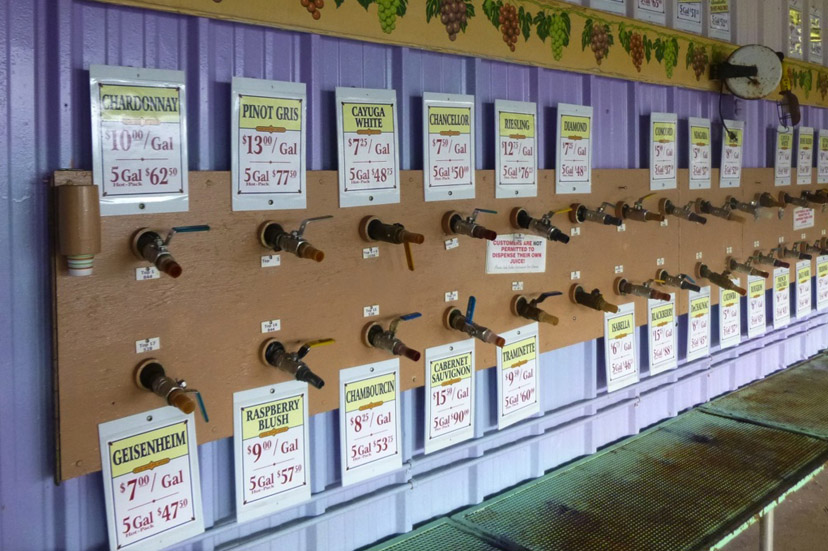Thermovinification for Improved Red Hybrid Wine Quality
This article is sponsored by Scott Laboratories. For more information on their product offerings, please contact Scott Labs at 800-821-7254 or send an email to info@scottlab.com
My first year of wine consulting in the Midwest also happened to be a tough year for winegrape growing. Grapes were classically unripe, low on brix and high on titratable acid. Fall was not cooperating and we were forced to harvest the winegrapes with less than ideal grape chemistry.
For one particular red hybrid varietal (to remain anonymous for fear of bastardization), there was also a lingering grassy note present in the grape skins that I knew would be tough to manage in winery. Yields were also low on this particular red and the winery had opted to source more of this varietal from out of state to compensate for lost production in the vineyard — only it came in the form of thermovinified (aka hot pressed) juice.
We had intentionally thought to segregate the two lots into two separate tanks to best assess treatment effects (estate grape vs. thermovinified juice) while keeping all other factors the same (yeast strain, nutrients, wine temperature profiles, etc.)
Upon completion of AF and MLF we did a blind test comparison, and I was shocked! The wine from the thermovinified treatment was hands down the winner — more fruit in the mouth, rounder and best of all there wasn’t a hint of greenness! How could this be?
Sure, the thermovinified juice was from a different growing region, but they too had faced a tough growing season so the corresponding wine should have suffered from the same downfalls as the estate grown grape wine. Suffice it to say, for the first time in my wine career, I thought that perhaps there is a time and place for thermovinified wines.
The Thermovinification Process
Thermovinification is a pre-fermentation process of heating whole or crushed grapes to promote the rapid extraction of phenolic compounds from grape skins, particularly color compounds (anthocyanins) in reds. Although the concept of heating must to obtain a rapidly colored juice has been around since as early as the 18th century, it’s only been in the past 40 years where the process has been industrialized. It is now commonly used in the grape juice industry and intermittently for large-scale wine production.
From a sensory perspective, for both hybrids and vinifera wines alike, the greatest benefit to thermovinification may very well be the reduction of ‘green’ attributes that are often difficult, if not impossible, to eradicate in the winery.
Thermovinification, or the modernized version of this process, Flash Détente, is used to reduce green bell pepper notes (IBMP) in vinifera-based wines such as Cabernet Franc, Cabernet Sauvignon and Sauvignon Blanc. For hybrids, Jackson (2000) notes that the reduction in vegetative, grassy notes also in turn promotes the natural fruity fragrances to become more apparent in hybrid wines.
Rick Walker, co-owner of Walker’s Fruit Farms & Wine Juice out of Forestville, NY, operates one of largest winegrape juicing operations east of the Mississippi. ‘We learned very quickly that when you press a red grape on a cold day you’re going to get a pink juice from it,” Walker said. “You’re only going to extract a very small portion of color.”
Walker went on to add, “Winemakers were quick to point out that the pink juice wasn’t any good. We found early that we really had to heat the reds in order to do justice. ” Hence the “hot press” method was quickly adopted. This year, Walker’s will hot press over 4,000 tons of product, a large majority being hybrid grapes.
Thermovinification in Action
In the industrialized process, grapes are de-stemmed, crushed and then cycled through a heat exchanger (see picture below.) During heating, the grape must is rapidly brought to a peak temperature of 100 – 176°F (80°C).

At Walker’s in New York, a heat exchanger is used to heat grapes and a cooler is used to store juice for retail sales
Walker errs on the cooler side of this target range- a peak temperature of 100 – 120°F. ‘There’s no need to go any hotter than that; we’re not trying to pasteurize or sterilize…that much heat extracts the pectins out of the skin and all the colors out of the skins we want,” Walker reports.
In general, the hotter the peak temperature, the shorter the duration of the heat cycle – ranging from a couple of minutes to several hours. In Walker’s setup, following the heating treatment, the must is pumped into a batch tank where it’s mixed with filter paper and rice hulls prior to pressing. The filter paper and rice hulls aide in clarification and pressing respectively.The juice is then pressed hot and cooled to 30F where the juice settles before being placed in cold storage.
The Benefits and Risks of Thermovinification
The obvious advantage to hot pressing, is the rapid extraction of color.
However, from a biological perspective, winemakers should be aware of three consequences of heating musts. The first, is that the native (or endogenous) yeast populations are heat killed. For most winemakers, this should obviously work to their advantage. However, this makes hot pressing a non-option for winemakers that are proponents of native (spontaneous) yeast fermentations.
Secondly, Botrytis-infected grapes can greatly benefit from hot pressing due to thermal denaturation of laccase enzyme that occurs at temperatures greater than 140°F (Laccase is at peak enzymatic activity just below this threshold.) Botrytis’s laccase is the notorious polyphenol oxidation enzyme known for causing browning in white wine and loss of pigmentation in red wine. Once present, it is hard to manage in the winery.
And lastly, although thermovinification is a quasi-pasteurization of pressed juice, the one downside is that native pectinases can also be thermally destroyed. Therefore, supplemental pectinases may need to be added to juice/wine either prior or during fermentation to aide in proper clarification of wines downstream from alcoholic fermentation.
Walker noted that he doesn’t foresee the need to add pectinases to his juice, because Walker’s adds pectinases upfront to grapes when they arrive for processing. (The author notes that the added pectinases are probably not degraded in Walker’s hot press system because the lower heat maximum during thermovinification.)
A German study found that the greatest benefit to thermovinified vinifera wines, relative to traditional fermentation methods (pumpover, manual cap punching and mechanized cap punching), was increased ester formation and a reduction in C6 alcohols aka Green Leaf Volatiles (Fischer et al., 2000.)
Esters are in part responsible for the fruity aromatics of a wine whereas C6 alcohols are often thought as negative attributes of a wine imparting green, grassy notes. I am not aware of any study assessing the effects of thermovinification on the aromatic (volatile) composition of hybrids. However, C6 alcohols have recently been found in one red French-American hybrid in significant quantities. Accumulation of the C6 alcohols in that study were linked to shoot thinning severity and harvest date treatments (Sun et al., 2011.)
Given C6 alcohols apparent connection to light, heat, and length of growing season, it makes sense that during tough growing seasons (cool, wet, lack of Growing Degree Days), an increased amount of ‘greenness’ would be present in harvested grapes and may very well have warranted the use thermovinification in the consulting scenario above.
Unprompted, Walker went on to add, ‘We found out early that some hybrids, particularly Foch, DeChaunac, Léon Millot, Rougeon, actually came out better when they’re hot pressed…because fermentation on the skins extracts a lot of astringency. With hot pressing, you won’t get the astringency that you would through [normal macerated] fermentation, but you do get all the color.”
Hmm, a lack of greenness, meets increased fruity aromatics, meets reduced astringency. Perhaps we’re onto something here for red hybrids…
Although it is hard for very many Midwest wineries to justify the upfront cost of purchasing a modern thermovinification system, in certain growing seasons for specific hybrid varietals, the sourcing of thermovinified juice may be justified and help improve overall wine quality.
Specifically, the red French-American hybrids appear to benefit the most from this treatment. And home hybrid winemakers have the option of experimenting with hot pressed juice because roughly 10% of Walker’s sales goes to home winemakers.
A “thank you” to Rick Walker for providing input for this story! Check out Walker’s Fruit Farm & Wine Juice for hybrid juice sourcing options at www.walkersfruitbasket.com.
Piero Spada received his MS from Cornell’s Viticulture and Enology program and was previously a winemaker in the Finger Lakes. Piero is now an independent vineyard and winery consultant based in Wisconsin and can be reached via email at pierospada.com





